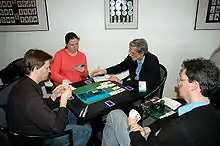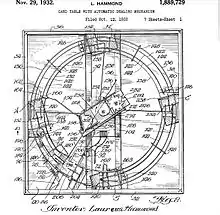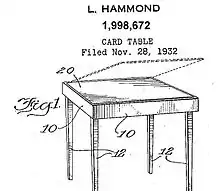Hammond Electric Bridge Table
The Hammond Electric Bridge Table was an electromechanical automatic card shuffling machine that dealt playing cards at random to four bridge players. The mechanism was built into a card table. The main concept of the machine was as a labor saving aid for bridge players in dealing out the hands. The invention was an offspring from the Hammond Clock Company as an additional product. It was a popular device when first introduced at the pre-Christmas season of 1932. That was short lived, however, and production lasted only a couple of years.

Development

The device has its origins with the Hammond Clock Company which was formed by Laurens Hammond in 1928 in Chicago, Illinois. By 1932, over one hundred clock companies had gone out of business due to the Great Depression but Hammond was determined to remain solvent and created new products for the company to sell. One such product was an automatic card dealer. Hammond was a bridge player and a mechanical engineer and he put the two together and invented the Hammond Electric Bridge Table.[1] This was an automatic playing card dealing apparatus that was specifically designed for use in contract bridge.[2] The electric bridge mechanism was patented on November 29, 1932 and the patent for the card table that contained it was filed the day before.[3][4] It was the first bridge table to automatically shuffle and deal cards using electricity.[5]
Production
Around 14,000 tables were made and a few thousand sold.[6][7] The sales were so brisk during the Christmas season of 1932 that the Marshall Field's department store in Chicago had taxicabs waiting at the factory to pick up lots of four or five tables and deliver them immediately to the store for their pre-Christmas sales.[7][8] In the month of December the profits from the electric bridge tables were $75,000 which saved the Hammond Clock Company temporarily.[9] The price was $25.[10] The deluxe model sold for $40.[11] This was expensive for the time, as the income in the United States had fallen due to the depression.[12][13] The electric bridge table was presented at the 1933 World's Fair in Chicago,[2] but sales declined after that and within a couple of years production was discontinued altogether.[10][14][15]
Description

The 28 inch square wooden card table was about 3 inches thick and looked like an ordinary bridge table.[16] The table came in two models, a standard one of walnut finish to the legs and frame,[17] and a deluxe model that additionally had matching veneer on the sides.[17] They both came with a masonite removable top (see "Card Table" patent).[17] Both models came with two electrical outlets under the table for an electrical cord to be plugged.[17]
The table had a built-in electromechanical mechanism hidden within the top that was referred to as the "brain."[7][18] It shuffled and dealt the cards automatically and gave a set of randomly picked bridge hands of four 13-card sets to each of the four players.[19] Since the mechanism did the shuffling, it always came out with the correct number of cards for each of the players.[19] When the table came out it was considered the ultimate convenience in a play-aiding device since players no longer had to deal out by hand[20] and it had the added benefit that cheating was impossible since the cards were dealt solely by the machine.[21] The players would play bridge while another set of cards was being dealt out by the mechanism and dropping them at random into the four player bins where they retrieved their 13-card sets.[7][22]
The deck of cards did not need shuffling beforehand.[18] It was simply placed into a built-in card deck holder in the table top.[18] One of the players would push in the holder which triggered a switch that started an electric motor within the mechanism.[18] This then swung a mechanical arm clockwise that had a rubber finger attached.[18] It then picked up the top card and passed it onto a second arm that decided which bridge player hand would get that card.[18] It had 635,013,559,600 different combinations of cards that any one player could be dealt.[23] It took about a minute for the electric bridge table mechanism to deal out to all four players the 13 cards required.[7] The complicated mechanical gears and levers of the mechanism were referred to by Hammond as a "robot".[2]
References
Citations
- Lee 2001, p. 155.
- ""Hammond Electric Bridge Table" Model 4H, 115. serial no. 7674. Chicago: Hammond Clock, Company [1932]". Christie's Auction. 2015. Retrieved August 15, 2015.
- "Card table with automatic dealing mechanism". Google Patents. U.S. Government. November 29, 1932. Retrieved August 15, 2015.
- "Card table US1998672 A". Google Patents. U.S. Government. Nov 28, 1932. Retrieved August 16, 2015.
- Kane 1997, p. 266.
- Lodder 2008, p. 10.
- NAWCC2001 2001, p. 175.
- Barry, Stuyvesant (1974). "Chapter XIII – The Electric Clock". Vintageorgans.com. Stuyvesant Barry. Retrieved August 16, 2015.
- "Bits and Pieces". Podcasts.ie. 2015. Archived from the original on September 27, 2015. Retrieved August 16, 2015.
Hammond's clock business ran into difficulties in the early 1930s, and he struggled to save his business through a number of other inventions, such as an electric bridge table and, slightly later, his famous organ.
- Vail 2002, p. 55-57.
- F-R 1932, p. 1, v 8.
- "The Hammond Organ story". Dutch. Hammond Orgel Club Holland. 2015. Retrieved August 16, 2015.
The bridge table was patented in November of 1932 and 14,000 were made and sold by Christmas for the high depression era price of $25. The line was discontinued, primarily because the national income had fallen to 60 percent of its 1929 level.
-
"The Hammond Story". Orgel Palle. 2015. Retrieved August 16, 2015.
The bridge table was patented that November and 14,000 were made and sold by Christmas at the rather high depression era price of $25, but the line was discontinued, primarily because the national income had fallen to 60 percent of its 1929 level.
- "The Hammond Story from a 50th Anniversary Hammond Company pamphlet". Vintage Hammond Organs. 2014. Retrieved August 15, 2015.
- "Pulling Out All The Stops". Arts+Labor+Austin. 2015. Archived from the original on 2015-09-23.
Needing a new money-maker after the Hammond Electric Bridge Table ran its course, selling 14,000 units in two years, Hammond based the organ on the synchronized motor he used for his clock.
- Wagnalls 1932, p. 22.
- Hill 1932, p. 257 v69 #6.
- Benn 1932, p. 22.
- Mitchell 1932, p. 51.
- Hoffmann & Ramirez 2013, p. 76.
- Wheeler 1932, p. 22.
- Bonnier 1933, p. 29.
- Sluder 2014, p. 12.
Sources
- Benn (1932). The Electrical Journal, Volume 114. Benn Bros., Limited.
- Bonnier, Corporation (1933). Popular Science. Bonnier Corporation.
- F-R (1932). The New Yorker. F-R Publishing Corporation.
- Hill (1932). Electrical West. McGraw-Hill Company of California.
- Hoffmann, Frank; Ramirez, Beulah B (16 December 2013). Sports & Recreation Fads. Routledge. ISBN 978-1-135-89474-0.
- Kane, Joseph Nathan (1997). Famous First Facts: A Record of First Happenings, Discoveries and Inventions in the United States, Fifth Edition. H. W. Wilson. ISBN 0824209303.
item #4024. The first bridge table to shuffle and deal cards by electricity was patented on November 29, 1932, by Laurens Hammond of Chicago, IL, who obtained a patent for a “card table with an automatic dealing device.” The unshuffled cards were placed in a sliding drawer that started the mechanism and delivered 13 cards to each player. The entire mechanism was concealed in the table. The table was manufactured by the Hammond Clock Company Chicago, IL, which marketed it in 1932.
- Lee, Laura (2001). The Name's Familiar II. Pelican Publishing. ISBN 1565548221.
- Lodder, Steve (2008). Classic Hammond Organ: Know the Players, Play the Music. Backbeat Books. ISBN 978-0-87930-929-9.
- Mitchell, John Ames (1932). Life. Life.
Hammond's new Electric Bridge Table, which shuffles and deals cards without benefit of human hands... That starts the automatic, scientific shuffling and dealing. The Hammond Electric Bridge Table deals it into a pocket in the side of the table— one in front of each player.
- NAWCC2001 (2001). NAWCC Bulletin. National Association of Watch and Clock Collectors, Inc.
- Sluder, Lan (11 September 2014). Play Bridge Today: Learn the Basics in Minutes!. Equator. GGKEY:AE2B8HT3SS9.
- Vail, Mark (2002). The Hammond Organ: Beauty in the B. Backbeat Books. ISBN 978-0-87930-705-9.
- Wagnalls (1932). The Literary Digest. Funk & Wagnalls.
- Wheeler, Edward Jewitt (October 1932). The Literary Digest.
External links
- Hammond Electric Bridge Table
- Color images of the Hammond Bridge Table
- Newspaper clipping on the Hammond Bridge Table
- Demonstration on how Hammond Bridge Table works
- Crazy antique robot table deals cards – high resolution